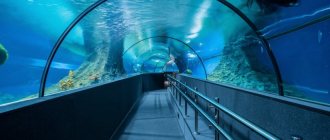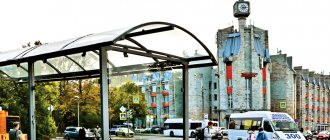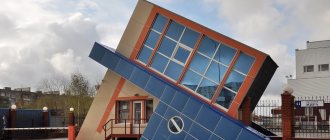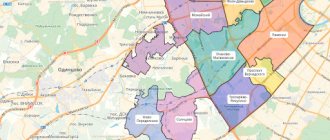It just so happened that my parents moved to the Murmansk region in 1989, due to distribution. Before that, they studied and worked in St. Petersburg. My father was a sailor, he was offered to move to the Black Sea, but with a wait of about 4-5 years for an apartment. Or move to the north, where the apartment was given out within a year. A young family, two children, the choice was obvious; their own apartment outweighed the advantages of the warm southern climate. The apartment was given out a year and a half after moving, in the city of Severomorsk, in a new, newly built building. Two-room apartment with a view of the bay. I love my parents’ apartment precisely for the view from the window. The bay, the other shore and warships are visible. Beauty!
But the city is in a ZATO!
Severomorsk is the capital of the Northern Fleet. A small but proud town of 54,000 inhabitants. The city is the center of the ZATO urban district of the same name (closed administrative-territorial entity).
There are other settlements in the ZATO, but they are very small, for several thousand people.
THEN means that it is not so easy to get into the city. At the entrance to the territory of the ZATO there are checkpoints where everyone is checked to see if they have the necessary documents: this is either a registration, a pass, or a military travel document.
Photo by Yana Fominykh
Everything is clear with registration, I showed my passport and that’s it. Passes must be made in advance. They are issued mainly to close relatives of those living in Severomorsk (for a year). Or to friends, distant relatives in connection with some important event such as a wedding, funeral, birthday. Such passes are given for several days. There are also passes that are issued by organizations operating on the territory of closed administrative territories for their employees. I won’t talk about the military, they have their own system. But I want to note that not every person can be issued a pass. Everyone for whom a pass is ordered is checked by all sorts of interesting structures that may refuse a pass without explanation. There are a lot of military installations in the city and district, which is why they are playing it safe.
Does the checkpoint and pass system interfere with local residents? Probably not, it's a matter of habit. This is annoying only during rush hour, when traffic jams form at the checkpoint, but everyone is used to it. Well, if you forgot your passport at home, you will not be able to leave the ZATO territory. Well, you know, for me the closedness of the city is a plus, somehow I worry less about the child, it seems to me that there is less crime here. Although, there is also enough, mainly in connection with alcohol (intoxication or the desire to drink). There are also asocial elements here. But they are in all cities.
Severomorsk is the capital of my destiny
Fate brought me in 1992, during the most turbulent years of the collapse of the Secular Union, to this small, closed-to-entry military garrison with a population of about 70 thousand. As of January 1, 2018, about 60 thousand people live in the city.
Entry into the city for adult citizens over 14 years of age is strictly with documents (children under 14 years of age only with their parents), with passes for relatives and business travelers. Even for friends this opportunity is not provided. The country's northern naval forces are still kept in strict secrecy.
If fate brings you to this city, don’t resist it; living in the far north is good luck! Test your fortitude and make new friends!
The northerners are a strong and strong people, with a strong character, with special tempering. The city is 70% military. Immediately upon arrival in the city, I fell in love with its atmosphere, friendliness and some kind of unity of the inhabitants, characteristic only of northern places. As they say, people with bad guts don’t live in such conditions. Of course, it’s slightly idealized, but there is something in it... The elite of the navy are officers, their educated wives are the backbone of the population of Severomorsk.
Photo from the Internet by Nurlan Ramazanov
Politeness and tact, honor and decency, are so inherent in people in uniform. This is felt externally, in interactions with each other, but to great disappointment in everyday life it does not manifest itself in the best possible way.
May the people reading from this cohort forgive me, but such a sometimes truly “caring” attitude towards the property in the entrance, towards the cleanliness around the house, is rarely seen anywhere. Everything is explained simply: life is temporary, here today - tomorrow to another garrison, everything here is someone else’s, not mine!
You can break the fences, throw a bag of garbage out the window, in the hope that people of a lower rank will come and clean it up... Written on walls of entrances, elevator cabins, mangled playgrounds, piles of garbage under the stairs - children's pranks of children and teenagers. People who serve under contract have a special reputation. There are legends and... jokes about their valiant exploits. Of course, the civilian population is far from behaving better, everyone here is temporary... However, I don’t want to talk about bad things...
Severomorsk night and winter street. Lomonosov, near the city administration building. Photo by Andrey Altukhov.
Job
There are a lot of military personnel and their families in the city who come on assignment. But there are also plenty of civilians not associated with the military. Everything is clear with the military - they serve. Many ordinary residents work in military units in civilian positions.
In addition to the military unit, it is not difficult to find work: salesperson, teacher, educator, physician, manager, administrative work. In some jobs, such as a teacher, there is a small additional payment for working on the territory of a closed administrative unit.
By the way, in the north there are polar workers, an additional payment to your salary. But they must be earned through work experience. But, for example, teachers and doctors do not need to earn this experience; they are given bonuses right away.
If you haven’t found a suitable job in Severomorsk, you can find it in Murmansk. This is a regional center. The drive to it is approximately 25 km. You can go by car or by public transport. The drive takes 25-40 minutes.
Photo by Elena Zababurina
Orthodoxy from scratch
After the collapse of the USSR, the life of Orthodox parishes in Severomorsk was built from absolute scratch. More precisely, it all began with the only temple of the holy martyrs Faith, Nadezhda, Love and their mother Sophia, erected at the turn of the millennium. Now a cathedral has been built in the name of St. Andrew the First-Called, the patron saint of sailors. This is the cathedral of the North Sea diocese, recently separated from the Murmansk diocese. Its territory covers the entire sea coast of the Kola Peninsula.
Annunciation Church of Kola. Photo Insider
Five centuries ago, the Christianization of the Murmansk north began. And in our time, the North Sea hierarchy sees the goal of its ministry in the re-Christianization of the fleet, the churching of sailors, and the revival of the traditions of the once God-loving Russian army. Bishop Mitrofan, himself a former naval officer who served in the same region and commanded a warship, knows well all the pain points and spiritual problems of the post-Soviet fleet.
Transport and roads
There are several city buses in the city itself. Although the city itself can be explored on foot if you have time and it’s not cold. The city is not very big.
Getting around the city on foot is made difficult by the fact that the city is divided into 2 parts: upper and lower. To get from one to the other you need to either make a big detour, and there will be a gentle climb, or climb long, long stairs (about 300-350 steps), which are called gangways here (like on ships).
City buses operate according to a schedule, which can be viewed on the Internet. There are several intercity buses. Several run between closed cities, and one (105) goes to Murmansk. Route 105 has both buses and minibuses. Previously, 105 buses ran very often, every 15 minutes, now they run less frequently, about once every 30-40 minutes.
Sometimes, in severe frost or snowfall, they may travel less often due to problems on the roads or with equipment. At rush hour it may be impossible to get on the bus, but in winter at −35 this is already critical.
The cost of travel in Severomorsk itself is 34 rubles, to Murmansk - from 80, depending on the stop.
You can get to Severomorsk by two roads, both go through Murmansk. The main road (short) was repaired this year, 2021. It is also being transferred to federal ownership, and a project is being prepared for its expansion and capital. repair. The second (bypass) road passes through the small town of ZATO - Severomorsk-3 and the settlement of Shchuka. It is very bad, it is mainly used by the military. There are checkpoints on both roads.
Main streets of Severomorsk
- Sovetskaya Street , one of the central streets of the city with many shops, a cinema and a branch of the international chain of stores “Fix Price”.
- Pikulya Street, if you look at the map of Severomorsk with streets and houses, you will notice that it passes mainly through the forest of the city, along it there are branches of Sberbank and gas stations.
- Kirova Street , consisting entirely of multi-storey residential buildings, along this street there is a Russian Post office and school No. 1.
- Sivko Street , goes around Central Park, a favorite vacation spot for the townspeople, where there is also a monument to Lenin.
Housing and communal services and houses
New houses have not been built in Severomorsk for the last 30 years. But the condition and facades of the buildings are monitored. In general, the town looks pretty well maintained. This is if you come to it in the summer. In winter it looks dejected - a lot of grayness. Although they have now begun to work on this: they paint facades in bright colors, paint murals (paintings) on the walls of houses. There are not many such houses yet, but they still inspire hope for a bright future.
There are 5-story buildings and 9-story buildings. There are no wooden two-story houses - why am I talking about this: there are still many such houses in Murmansk, and yes, people still live in them, they can’t resettle them. In the north, with our climate, this is simply a mockery of people.
The heating works smoothly and accidents are rare. The heating is turned on in early-mid September and turned off in May-early June, depending on the outside temperature. In the summer, without heating, apartments can be very cold, especially if the summer is cold. And here in July it can be +5, and in June it snows at least once. Therefore, there are heaters in all apartments.
In winter, the house can be warm, but sometimes not so much. It’s always hot in my mom’s apartment, but in our apartment, if it’s below -10 outside, we definitely can’t go barefoot and in a T-shirt, even though we’re hardened.
Payments for housing and communal services are high - for a one-room apartment they pay approximately FROM 5 thousand and above, for a two-room apartment FROM 7 thousand, and this is with more or less economical use of water and electricity. From personal examples: friends for three rubles (family of 4 people + dog) pay 12 thousand for a communal apartment. I pay 8 thousand for a two-room apartment (3 people).
The quality of water supplied to apartments, in general, does not raise any questions. In Murmansk, in some areas, it is much worse.
In the courtyards, old ones are gradually being renovated and new playgrounds are being built. At least there is somewhere for the children to go for a walk. And then in 2000-2010 you go out into the yard, and there’s even nowhere to go for a walk, and you run to jump on roofs in garages or climb into an abandoned factory, everything is more fun than in an empty yard.
Climate of the Kola Peninsula
The climate of Kola is maritime, continental, in recent years almost all year round with the same temperature from minus 5º to plus 5º











